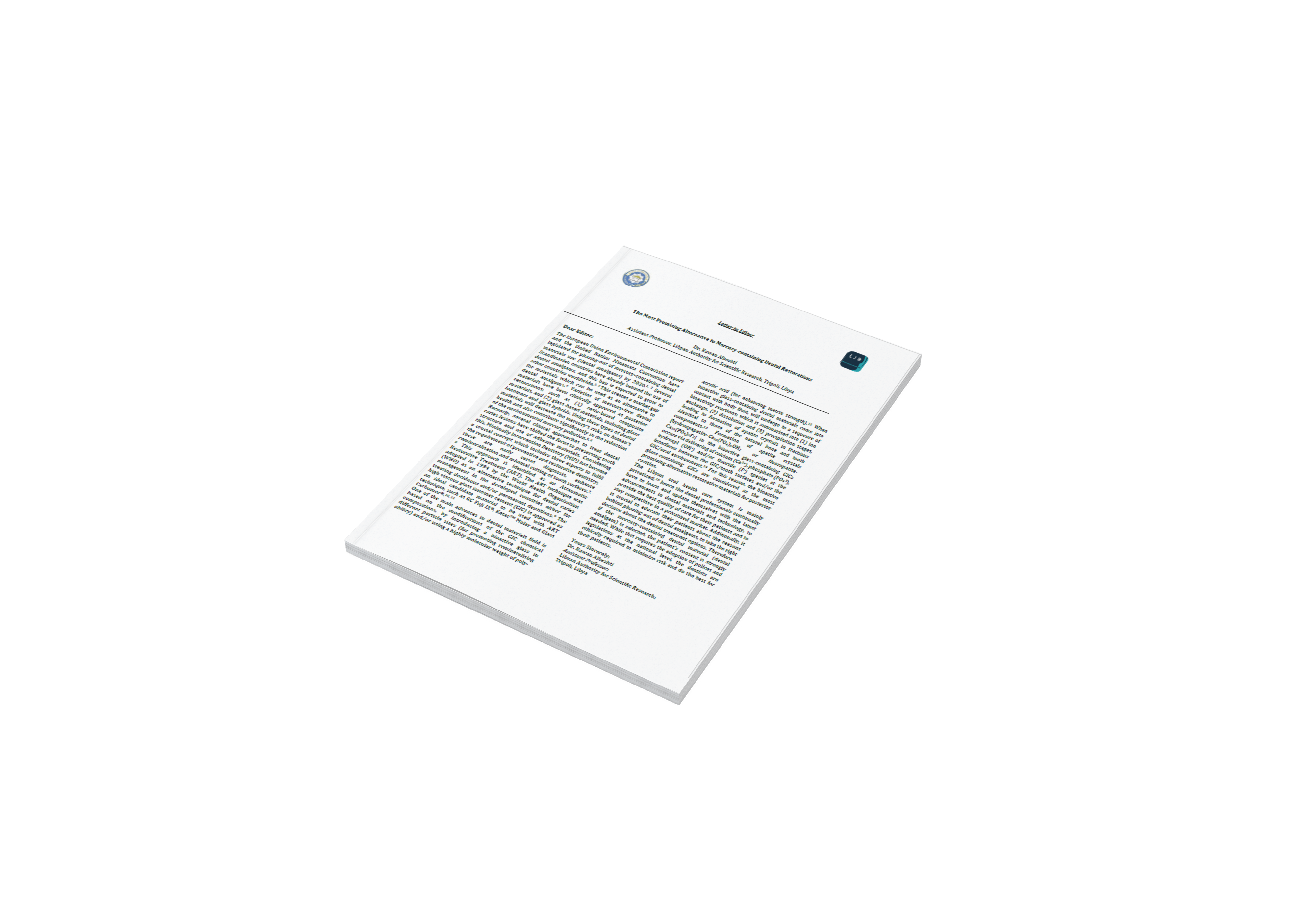The Most Promising Alternative to Mercury-containing Dental Restorations
DOI:
https://doi.org/10.37376/ljd.v8i2.7157Abstract
The European Union Environmental Commission report and the United Nation Minamata Convention have legislated for phasing-out of mercury-containing dental materials use (dental amalgams) by 2030.1, 2 Several Scandinavian countries have already banned the use of dental amalgams, and this ban is expected to grow to other countries worldwide.2, 3 This creates a market gap for materials which can be used as an alternative to dental amalgams.4 Varieties of mercury-free dental materials have been clinically approved as posterior restorations; such as (1) resin-based composite materials, and (2) glass-based materials, including glass ionomers and glass hybrids. Using these types of dental materials will decrease the mercury’s risks on human’s health and also contribute significantly in the reduction of the environmental mercury pollution.5, 6
Recently, several clinical approaches to treat dental caries lesions have shifted the focus to preserving tooth structure and use of adhesive materials. Considering this, Minimally Intervention Dentistry (MID) has become a crucial concept which includes three aspects to fulfil the requirement of preventive and restorative dentistry; these are early caries diagnosis, enhance remineralisation and minimal cutting of tooth surfaces.7, 8 This approach is identified as an Atraumatic Restorative Treatment (ART). The ART technique was adopted in 1994 by the World Health Organisation (WHO) as an alternative technique for dental caries management in the developed countries either for treating deciduous and/or permanent dentitions.9 The high viscous glass ionomer cement (GIC) is approved as an ideal candidate material to be used with ART technique; such as GC Fuji IX®, KetacTM Molar and Glass Carbomer®.10, 11
One of the main advances in dental materials field is based on the modifications of the GIC chemical compositions, by introducing a bioactive glass in different particle sizes (for promoting remineralising ability) and/or using a highly molecular weight of poly-
acrylic acid (for enhancing matrix strength).12 When bioactive glass-containing dental materials come into contact with body fluid, will undergo to a sequence of bioactivity reactions; which is summarised into (1) ion exchange, (2) dissolution and (3) precipitation stages, leading to formation of apatite crystals in fractions identical to those of the natural bone and tooth components.13 Formation of apatite crystals [hydroxyapatite-Ca10(PO4)6OH2 or fluorapatite-Ca10(PO4)6F2] in the bioactive glass-containing GICs occurs via delivering of calcium (Ca2+), phosphate (PO43), hydroxyl (OH-) and/or fluoride (F-) species at the interfaces between the GIC/tooth surfaces and/or the GIC/oral environment.14 For this reason, the bioactive glass-containing GICs are considered as the most promising alternative restorative materials for posterior cavities.
Downloads
References
Jebur N, Vinall-Collier K, Umair A-A, Aggarwal VR. Dental amalgam teaching phase-out-a step too soon? Foundation trainees' experience of amalgam use in dental school compared to practice: a mixed-methods survey. Br Dent J. 2023;235(5):329-34.
Harjunmaa U, Auero M. Plan for the abolition of dental amalgam by 2030: National plan required by an EU regulation. 2019.
Fisher J, Varenne B, Narvaez D, Vickers C. The Minamata Convention and the phase down of dental amalgam. Bull World Health Organ. 2018;96(6):436-38.
Schmalz G, Schwendicke F, Hickel R, Platt JA. Alternative direct restorative materials for dental amalgam: A concise review based on an FDI policy statement. Int Dent J. 2023.
Ajiboye AS, Mossey PA, Fox CH. International Association for Dental Research Policy and Position Statements on the Safety of Dental Amalgam. J Dent Res. 2020;99(7):763-8.
Keane M, Lee C, Long J. Measures to reduce the clinical need for dental amalgam: evidence review. 2020.
Frencken JE, Pilot T, Songpaisan Y, Phantumvanit P. Atraumatic restorative treatment (ART): rationale, technique, and development. J Public Health Dent. 1996;56(3):135-40.
Nicholson J. Glass ionomer dental cements: update. Mater Technol: Adv Perform Mater. 2010;25(1):8-13.
Frencken JE. Evolution of the the ART approach: highlights and achievements. JAppl Oral Sci. 2009;17(SPE):78-83.
Koenraads H, Van der Kroon G, Frencken J. Compressive strength of two newly developed glass-ionomer materials for use with the Atraumatic Restorative Treatment (ART) approach in class II cavities. Dent Mater. 2009;25(4):551-6.
Zainuddin N, Karpukhina N, Law RV, Hill RG. Characterisation of a remineralising Glass Carbomer® ionomer cement by MAS-NMR spectroscopy. Dent Mater. 2012;28(10):1051-8.
Hill R. Glass ionomer polyalkenoate cements and related materials: past, present and future. Br Dent J. 2022;232(9):653-7.
Hench LL. The story of Bioglass®. J Mater Sci: Mater Med. 2006;17(11):967-78.
Ten Cate J, Van Duinen R. Hypermineralization of dentinal lesions adjacent to glass-ionomer cement restorations. J Dent Res. 1995;74(6):1266-71.
Aloshaiby A, Gaber A, Arheiam A. The oral health care system in Libya: a case study. BMC Oral Health. 2024 Aug 3;24(1):888.

Downloads
Published
How to Cite
Issue
Section
License
Copyright (c) 2025 Libyan Journal of Dentistry

This work is licensed under a Creative Commons Attribution-NonCommercial-NoDerivatives 4.0 International License.







